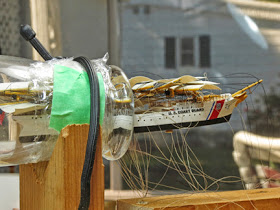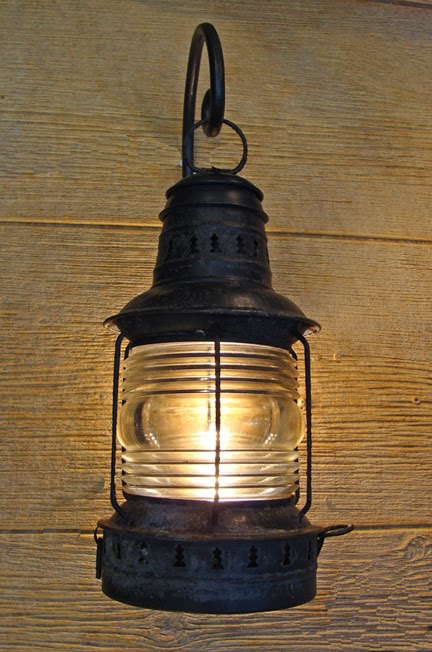Recently, I was hunting around on Pinterest (nautical furnishings and furniture) and came across an image of an aluminum ship's window re-purposed into a nautical mirror. This picture was linked to a blog written by Courtney Price titled "The Hampton Designer Show-house" where top interior designers turn a New England home into a, as the author describes it, "decorating masterpiece." The house located in Bridgehampton, New York was certainly dressed up in top fashion.
 |
| Authentic ship fixtures re-purposed and used to create this beautiful nautical bathroom. By New York design company Melanie Roy Design. |
Part of the first floor (bath and mudroom) was designed by New York designer Melanie Roy of Melanie Roy Design selecting a strong blue and white striped wall covering and navy blue walls contrasting white painted wood trim and bathroom cabinet with polished steel drawer pulls and bath fixtures. The mirror and lights above the bathroom sink were re-purposed ship salvage items including a ship's window converted into a mirror (could also be the front of a medicine cabinet) flanked on both sides with 90 degree aluminum caged passageway lights. (see below).
This is a beautiful example of utilizing authentic, high quality nautical fixtures, re-purposed and used once again as part of creating a very attractive nautical inspired bathroom. Kudos to designer Melanie Roy!
An authentic ship's porthole window recycled from the shipping industry that we've re-purposed into an impressive nautical mirror. These 2 dog porthole frames are made out of ALUMINUM and to the highest marine specifications, salvaged from British and European ships built in the 1970's/ 80's. Aluminum portholes are much lighter than their brass and bronze predecessors which makes them usable as a wall hanging in any nautical/coastal interior. Aluminum portholes are also a perfect choice for bathrooms with brushed nickel and stainless steel fixtures! The overall diameter of the porthole measures 16 X 20 inches and the mirror measures 12 X 16 inches. The projection from the wall including the dogs is 5 1/2 inches. The weight is approximately 16 pounds. Here's the link: Aluminum porthole mirrors.
Here's the link: Aluminum porthole mirror
Shown here is our high quality cast aluminum 90 degree bulkhead (passageway) lights are designed after vintage ship lights. Features an aluminum screw-bezel style cage and clear glass cover. We recommend a fluorescent or LED type bulb for long life and minimal heat build-up inside the fixture. This is an aluminum version of our cast brass bulkhead light -- it weighs less than the brass and is perfect for installations where weight is a concern. Measures 4.5" wide, 11.5" long and projects about 7.5". Here's the link: 90 degree aluminum passageway light
A smaller version of our aluminum passageway light is our new, high quality, cast aluminum 90 degree bulkhead (passageway) lights designed after the larger, vintage ship lights. Features a polished aluminum screw-bezel style cage with clear glass insert. The light measures 3 inches wide and 7 1/2 inches tall not including the round back plate. The back plate is designed to cover a standard round electrical box and measures 4 inches in diameter. Mounts using two screws 3 1/2 inches apart. UL rated 75 W 125V socket for candelabra style bulbs. Highest quality light of it's type on the market! Here's the link: Small 90 degree passageway light
Skipjack Nautical Wares & Marine Art Gallery is a major supplier of authentic nautical lighting, ship salvage, custom furniture and furnishings, decor and marine art to the interior design trade. Visit our web store at Skipjack Nautical Wares & Marine Art Gallery or stop by our riverfront showroom located in historic Olde Towne Portsmouth, Virginia.
Skipjack Nautical Wares
& Marine Art Gallery
& Marine Art Gallery
620 High Street, Portsmouth, VA. 23704 757-399-5012
www.skipjacknauticalwares.com



















.jpg)



















